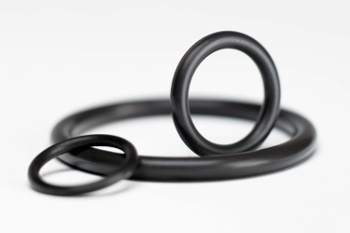 |
| August 02, 2016 | Volume 12 Issue 29 |
Designfax weekly eMagazine
Archives
Partners
Manufacturing Center
Product Spotlight
Modern Applications News
Metalworking Ideas For
Today's Job Shops
Tooling and Production
Strategies for large
metalworking plants
Automotive: 3 global trends driving seal innovation

By Dan Ewing, Senior Chemical Engineer,
Parker Hannifin O-Ring Division
There are three global trends driving innovation in the automotive industry:
- The desire to drive farther and release fewer emissions from every unit of fuel,
- The need to last longer without maintenance, and
- Less tolerance for evaporative emissions caused by minor leaks, particularly at low temperatures.
All three priorities have driven significant change in vehicle and component design in just the last 10 years and will only continue. These trends are readily apparent in ever-more-demanding requirements for fuel-injector seal materials, and Parker compound VG286-80 offers unmatched benefits in all three areas.
For many years, the incumbent technologies in automotive fuel injection have been low-temperature fluorocarbon compounds. With the newer fuel systems, VG286-80 offers several improvements that make it the material of choice for fuel-injector applications.

Fuel-injector pressures
Injecting high-pressure fuel directly into the combustion chamber has driven up the mileage that can be squeezed from each drop of gasoline or diesel. In the days of carburetion, gasoline was delivered under vacuum. With fuel injection, fuel began to be delivered to the intake manifold at close to 100 psi of gauge pressure. With direct injection, fuel line pressures are reaching several thousand psi and are projected to continue increasing.
This has multiplied the mechanical demands placed upon fuel-injector seals to the point that extrusion failure can now be observed during testing. While this is new for the automotive industry, Parker has a considerable amount of history combating this failure mode in the fluid-power and oil-and-gas industries. We have incorporated knowledge and experience from working on extreme-pressure applications in the oil-and-gas industry into the development of VG286-80.

One of the things we "cross-pollinated" from oil and gas to automotive was pressure testing. Pressure testing in a fuel injector is difficult because of the size of the fuel injectors. Rather than trying to duplicate a fuel injector, we developed an extreme-pressure test rig that allowed us to compare different material for pressure resistance. This test rig can pressurize an O-ring gland up to 15,000 psi (103.4 MPa) at temperatures up to 150°C.
To accelerate the failure process, the clearance gap is substantially larger than is typically seen in fuel-injector applications. If the material reaches the full pressure without extrusion failure, the pressure is held for 10 minutes before depressurizing and cooling to room temperature. This cycle is repeated until the seal fails (defined as sudden system pressure loss). Most seal materials extrude and fail prior to achieving the full 103.4 MPa. This provides a numerical basis for comparing the pressure resistance of different materials.
When we tested VG286-80 side by side with a common GFLT compound of similar hardness, VG286-80 showed a 25 percent improvement in pressure resistance. In fact, VG286-80 almost got to the full 15,000-psi test pressure before it extruded. Unfortunately, we weren't able to test a GLT compound in this test rig.

Low-temperature performance
One of the key drivers for fuel injectors is low-temperature seal performance. As I mentioned before, fuel injectors have been using low-temperature fluorocarbon compounds for many years. Those in the GLT family have a TR-10 of -30°C, and those in the GFLT family offer a -24°C TR-10 coupled with excellent resistance to alcohol-containing fuels. VG286-80 beats both incumbent materials by a significant margin.

Being better for the sake of being better isn't important unless it means something in the application. In most applications, O-rings can seal down to about 8°C below their TR-10 value in static applications such as fuel injectors. The goal in the automotive industry is to seal at -40°C without leakage. For the GLT-type compounds, that's realistic -- but just barely. The GFLT-type compounds don't really get there, and that can cause small leaks during low-temperature fuel-injector tests. Ten years ago, this was considered acceptable, but with increasing scrutiny of leakage, these results are becoming more problematic. In comparison, VG286-80 has room to spare at -40°C.
Another phenomenon comes into play in high-pressure gasoline direct-injection systems. Just like high pressure causes the boiling point of water to shift upward, high pressure also causes the TR-10 and the glass transition point of elastomers to shift upward. For approximately every 750 psi (5.2 MPa), the freezing point of an elastomer increases (gets worse) by 1°C. In a 15-MPa (2,175-psi) gasoline direct-inject fuel-injection system, the elastomers in the fuel system can experience a 3°C upward shift in their low-temperature performance. Under high pressures, this is enough to cause GLT-type O-rings to leak at high pressures. In comparison, VG286-80 still has some additional safety factors in terms of low-temperature flexibility.
Alcohol-containing fuels
Another notable area of development has been in the use of bio-derived renewable fuels. Supplementing gasoline with bio-sourced ethanol or methanol provides emission credits for a vehicle manufacturer, but it can wreak havoc on legacy seal materials. GLT-type fluorocarbon seal materials degrade quickly in methanol fuel blends and those with high ethanol concentration. VG286-80 has chemical resistance that's more like the GFLT-type materials.

Longevity
Today, a good number of new cars come equipped with powertrain warranties that cover 100,000 miles, and some vehicle warranties are good for up to 10 years. In addition, the average age of all cars on the road in the United States is 11.4 years, and expected resale values -- which are strongly influenced by vehicle longevity and repair histories -- drive both lease and purchase deals. This gives manufacturers a strong incentive to ensure vehicles remain functional and leak-free for at least a decade.
Unfortunately, the wizards of computer modeling haven't figured out how to predict exactly how long a seal will last in a particular application. (When they do, I'll be blogging on that momentous development.) In the meantime, we have to make do with relative comparisons of expected service life based on compression set and compressive stress relaxation.
There is a lot of debate in the industry about which is better, compression set or compressive stress relaxation (CSR.) Compression set is a lot easier to run and more repeatable, and the two tests tend to go hand in hand. A compound that is good for compression set is also good for CSR. Both tests have their place, but for a quick comparison of materials, compression set offers a good snapshot. VG286-80 offers compression set resistance (and, by extension, expected service life) that's on par with GLT compounds and significantly better than GFLT compounds.

Summary
Traditionally, seal material selection for fuel injectors came down to a choice of two less-than-ideal options: Use a GLT fluorocarbon and suffer poor resistance to alcohol-containing fuels, or use a GFLT fluorocarbon that is great in the fuels but leaked a little at low temperature and didn't last as long. Adding the high pressures of gasoline direct injection made this choice even more difficult. Not only does it cause seal materials to extrude and fail, but it also makes low-temperature leakage worse.
VG286-80 solves all of these issues. It has even better low-temperature flexibility than the GLT-type materials, the same resistance to alcohol-containing fuels as GFLT, similar compression set to GLT, and more than enough pressure resistance to handle the mechanical demands of injecting gasoline directly into the combustion chamber.
For more information on this or other Parker materials, visit the Parker O-Ring Division or speak online with a Parker experienced applications engineer.
Read more informative blogs from Parker Hannifin at http://blog.parker.com/.
Republished with permission from Parker Hannifin.
Published August 2016
Rate this article
View our terms of use and privacy policy
